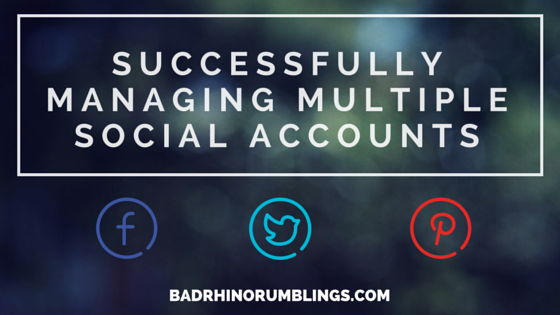
.
My daily job responsibilities include managing more than 30 social media accounts. No, I’m not kidding you. I work for a local medium-sized business that has 7 automotive stores across the state. Each store, as well as a corporate “umbrella” location, has its own Facebook, Twitter, Google Plus and Instagram accounts. With a help of little calculation, we arrive at 32 social accounts I manage daily. This situation is not uncommon. A lot of times a single company encompasses several distinct product offerings. Usually companies can be sliced and diced based on:
- Location (Whole Foods Market has a corporate page, district pages and even separate pages for the largest stores),
- Brands they sell (a company I work draws division by a brand they sell), and
- Types of products (when one company has multiple lines of business).
Even though it’s a common situation, most of businesses have one designated person to worry about all of the digital image. One manager has control over the entire image and has to be careful as to not confuse potential and existing customers. This person also has to bring the most value to clientele while treating each line of business in its own separate right. Finally, should the company even worry about those things; and what do you if you’re faced with managing multiple digital accounts that serve different markets?
Get clear on overarching image
Before moving any further into developing your digital marketing plan, you have to get clear on overarching brand image. Although you may have different divisions, brands and locations, there should be a reason why your corporation is the way it is. Try answering these questions as a baseline for brainstorming:
- What is the value of a company as a whole?
- Why it encompasses different divisions the way it does?
- What connects all of the separate accounts?
While Proctor and Gamble sells everything from food items to household cleaning products to cosmetics and health care products, their overarching message portrays the enterprise as a family-oriented company that makes quality products for all everyday needs.
Develop consistent messaging
Once you decide on the value that this complex structure brings as a whole, think of the message that all other sub-domains can encompass. Mix the overall value into the specific propositions. Most of the time, one company will have the same tone and feel to it, because, again, there is an underlying reason as to why a company’s portfolio is comprised the way it is. If corporate image is austere, serious and professional, the tone should be the same across all of its propositions. If a brand is hip and cool, it should showcase that trendiness across all of the propositions.
Virgin Group consists of hundreds of product offerings, including banking, jewelry, health care, communications and transportation industries. Yet, the core of such diverse portfolio lies in travel, entertainment and lifestyle domains. The company’s many brands boast stylish, fun-loving yet inspirational image. It is also not surprising that Virgin Group cleverly incorporates the same colors and visual clues in its logos and overall visual communication. While separate divisions of your company will probably have different logos, it’s still a good idea to tie them all together as to not confuse your audience. Plus, use this as an opportunity to further educate them on a spectrum of your propositions.
Know your audience
This goes back and forth with the first point: your audience will determine your overall messaging and image, while your various propositions will adjust your target audience accordingly. If your value propositions make your target audience very diverse, you should skillfully separate them while tying it all in with logic. It should make sense why all of these products and/or services are presented together, yet can be enjoyed separately. It is a difficult, nonetheless achievable task that you will need to spend time on. Take for example, Toyota Motor Corporation. Their portfolio includes
- Toyota, a brand synonymous with everyday commuter and value
- Lexus, which is synonymous with luxury, and
- Scion, a youth-oriented proposition that builds on Toyota’s dependable image, yet mixes in a sense of urban coolness.
Toyota does not try to disguise the fact that the three brands are part of one family of dependable vehicles, yet it makes sense that the three brands are separated into their distinguished divisions.
Decide on digital representation
Now that you’re clear on the value proposition, the messaging and the audience, it’s time to decide whether it makes sense to have an all-encompassing corporate social media presence or to create a separate representation for each division. Even if you decide to go with multiple accounts, don’t hesitate to act like one company – share each other’s updates once in a while. It will also save you a ton of time if you come up with all kinds of shortcuts for producing or curating content. For example, if the only separation exists in location, you clearly can share the same brand updates. Likewise, if your company specializes in one type of products, you can share news that will be relevant to all or most of the brands (for example, big auto show news or tips on how to keep a car in top shape).
Look for other things that bring people together, things that can be shared across all accounts and networks – examples being big national holidays, industry-related questions and humor. The latter is the best example of content that is appropriate in almost every industry. Make sure that humorous content is not offensive, yet very relatable in a given situation. I’m no automotive whiz. Yet, by examining what works and what interests my audiences, I was able to find a few common grounds and a few surefire ways to engage them. Those were humorous posts (mentioned above) and pictures of cool-looking vehicles.
[tweetthis url=”http://snip.ly/SCi0″]Managing multiple digital and social accounts is not as daunting as it seems at first.[/tweetthis]
Have an editorial schedule
I personally find that editorial calendar roughly planned out one month ahead keeps me focused. While all of those content pieces might not be in “ready-to-publish” state, I’m aware of what’s coming up next and able to plan accordingly. In the beginning of each month, I think of all the ways I could highlight anticipated industry happenings in a short blog post that gets published on all accounts. I also look for any trends or events that are worth a separate mention (say, unveiling of a new product or a major sales event). Then I sprinkle in store-specific events and finally a few “entertaining,” highly-visual posts that drive lots of engagement and mix up things a bit. Don’t forget that “recycling” content makes your life easier, saves tons of time and highlights your older content. For example, you could do a “#tbt” and link to an older post or an image that is still relevant. You can also take older popular blog posts and transform them into videos or infographics.
Try, experiment and take occasional risks
Since you have control over a few accounts and audiences, use this flexibility as an occasional springboard for ideas. Sometimes these ideas come from bigger brands or followers on one account but they could be easily applied or reworked to fit other accounts when adjusted to image and audience accordingly. One of the best examples of that would be contests or crowdsourcing campaigns. Don’t forget to experiment occasionally. Most of the time, distinctive audiences have the same pain points, such as increasing productivity, having more information for decision making, cutting time on mundane activities, decreasing monetary spend, etc. A lot of ideas can be tweaked a little to provide a solution for separate audiences.
Employ technology
Finally, don’t forget that technology makes our life easier. It can lift off some responsibilities from our shoulders and make us more productive. For example, I highly recommend Hootsuite or Buffer (or a combination of two) to truly manage a lot of separate social accounts. Hootsuite and Buffer enable you to curate quality relevant content with ease with their “Suggested Content” feature. You can schedule updates on Twitter, Facebook, Google Plus and so many more other popular platforms. I also use Hootsuite for social listening and trends insight. Don’t hesitate to schedule content at least a week in advance so that you can use all the freed up time to engage with followers. If you decide to use Hootsuite, you can also schedule weekly and monthly PDF reports that will arrive to your and boss’ inboxes automatically (saving you time going through separate accounts and collecting and organizing important data).
Conclusion
Managing multiple digital and social accounts is not as daunting as it seems at first. The first thing you need to do simplify your life and company’s practices is to get very clear on overall branding, messaging and positioning. Then, don’t hesitate to experiment and recycle content as much as possible. Finally, don’t forget that there are tons of tools designed to simplify a marketer’s job. Do you have experience managing multiple accounts? If so, what have and haven’t worked? Share in the comment section below.


